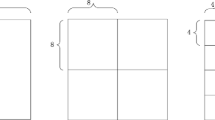Abstract
H.264 improves the coding efficiency by adopting rate distortion optimization (RDO); however, it yields high computational complexity. In order to reduce the intra-frame coding time, a fast and effective intra-prediction mode selection algorithm is proposed. The minimum sum of absolute differences between sub-block and its marginal weighted-pixels are used for selecting the candidates of prediction modes to speed up the intra-prediction process with an early termination criterion. Experimental results show that the proposed method can reduce the encoding time by more than 63% comparing with JM (Joint Model) software and is better than the previous algorithms, with negligible loss of coding performance.
Similar content being viewed by others
References
Wiegand T, Sullivan G J, Bjontegaard G, et al. Overview of the H.264/AVC video coding standard[J]. IEEE Trans on Circuits and Systems for Video Technology, 2003, 13(7): 560–576.
Kim T J, Hong J E, Suh J W. A fast intra mode skip decision algorithm based on adaptive motion vector map[J]. IEEE Transactions on Consumer Electronics. 2009, 55(1): 179–184.
Wei Geng, Liu Wenyu, Li Pengfei. Low complexity mode selection for H.264 based on motion region partitions[J]. Journal of Computer-Aided Design and Computer Graphics, 2008, 20(1): 93–98(Ch).
Jeong J, Kwon D N. DCT based fast 4×4 intra-prediction mode selection [C]//Proc 4th IEEE Consumer Communications and Networking Conference. Las Vegas: IEEE Press, 2007: 332–335.
Liu Jia, Dong Jinming. An improved intra-frame prediction mode selection algorithm for H.264/AVC[J]. Journal of Electronics and Information Technology, 2009, 31(5): 134–139(Ch).
Tsai A C, Wang J F, Yang J F, et al. Effective subblock-based and pixel-based fast direction detections for H.264 intra prediction[ J]. IEEE T Circ Syst Vid, 2008, 18(7): 975–982.
Tian Guifen, Zhang Tianruo, Wei Xianghui, et al. An efficient fast mode decision algorithm for H.264/AVC intra prediction[C] //Proc 1st International Congress on Image and Signal Processing. Sanya: IEEE Computer Society, 2008: 411–415.
Li Shiping, Jiang Gangyi, Yu Mei. New fast mode selection for intra prediction[J]. Acta Electronica Sinica, 2006, 34(1): 141–146(Ch).
Tseng C H, Wang H M, Yang J F. Enhanced intra-4×4 mode decision for H.264/AVC coders[J]. IEEE T Circ Syst Vid, 2006, 16(8): 1027–1032.
Moon Y H, Kim G Y, Kim J H. An improved early detection algorithm for all-zero blocks in H.264 video encoding[J]. IEEE T Circ Syst Vid, 2005, 15(8): 1053–1057.
Sousa L A. General method for eliminating redundant computations in video coding[J]. Electron Lett, 2000, 36(4): 306–307.
Author information
Authors and Affiliations
Corresponding author
Additional information
Foundation item: Supported by the National High Technology Research and Development Program of China (863 Program) (2006AA040307)
Biography: WU Bentao, male, Ph. D. candidate, research direction: multimedia signal processing.
Rights and permissions
About this article
Cite this article
Wu, B., Wu, M. An improved intra-prediction algorithm for H.264. Wuhan Univ. J. Nat. Sci. 15, 340–344 (2010). https://doi.org/10.1007/s11859-010-0663-1
Received:
Published:
Issue Date:
DOI: https://doi.org/10.1007/s11859-010-0663-1



